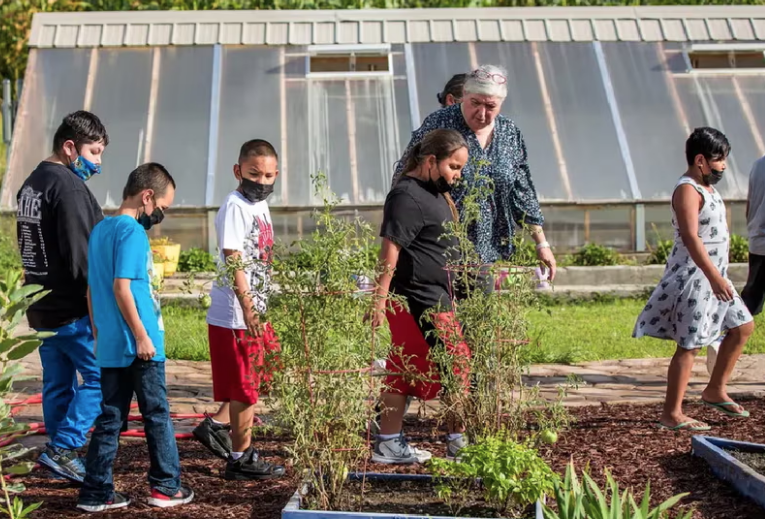UMÓⁿHOⁿ (OMAHA) NATION PUBLIC SCHOOL CASE STUDY
Students harvest jobs and health benefits for generations of Native Americans
Partners
- UMÓⁿHOⁿ (Omaha) Nation Public Schools
- Nebraska Vocational Rehabilitation
- The Center for Rural Affairs
- United Way of the Midlands
Challenges
- For young Native Americans of the indigenous UMÓⁿHOⁿ Nation living in Macy, NE, the nearest well-paying jobs were more than 90 miles away, resulting in one of the highest unemployment and poverty rates in the state.
- Many students wanted to stay in the community rather than leave their families and indigenous heritage behind.
- Macey is a food desert. There are no grocers except for a convenience story with basic food options. food insecurity – estimated at nearly 24% – affecting tribal communities in the aftermath of colonialism. About 68% of Native American children qualify for free lunches, the most reliable and nutritionally balanced meals they eat.
- High obesity and cancer rates and an 80% adult diabetes rate wracked the community.
- The community relies on the government for sustenance and does not have access to the best food options.

Barrier Removal
- Access to local jobs
- Access to healthier food
- Resilience and solutions rather than relying on help from others
Solution
- Based on a needs assessment JAG Nebraska Specialist Ricardo Airza conducted with his Umoⁿhoⁿ Nation Public Schools students, the class decided to utilize a plot of land to grow produce. They wanted to create a project that didn’t just help their career prospects but also gave back to a community with which they have deep connections thanks to their proud heritage.
- Students plant, care for, and harvest the food using both modern and traditional techniques that have been passed down for generations.
Progress
- The Garden has grown from eight acres to 15, encompassing 11,000 square feet of both food and pollinator habitats.
- The garden harvests three tons worth of produce annually.
- More than 25,000 plants are harvested each growing season.
- The students are providing and distributing healthy, affordable food to the members of their community.
- The students are learning to find solutions rather than seek help elsewhere, building character, resilience, and adaptability.
- It creates opportunities for education and applying employability skills transferable to many fields:
- Agriculture, growing, and cultivation techniques
- Food processing and preservation
- Freeze-drying and dehydrating fruits and vegetables
- Pricing and selling
- Entrepreneurship
- Customer Service
- Students learn financial literacy.
-
- In cashing their checks, students needed to learn how to open a checking account.
- Learning about the importance of documents such as tribal cards, identification cards, birth certificates and social security.
- In cashing their checks, students needed to learn how to open a checking account.
-
- In the spring of 2023, a new project was started in Elk Park to plant fruit trees.
Outcomes
Program Engagement:
- Students receive job skills while also finding ways to honor their heritage.
- Students have learned how to communicate among themselves and with community members.
- According to Richard Valentino, a cultural educator at UMÓⁿHOⁿ Nation Public Schools, “some of the students struggled to talk to adults or their peers before working in the garden.
- The project has brought the whole community together.
- Older members of the community have come to the garden and shared their heritage and stories with the students working the garden.
- Many students reinvest some of the money they earn back into the community.
- Job creation in the community
- Local and international recognition
- The garden has drawn the attention of tribes and tribal schools nationwide and internationally.
- “They’ve come from as far as Guatemala, Alaska and Hawai’i and as near as Nebraska, Kansas, and Iowa” – ITC
- Tribal leaders from other nations have visited to learn about the garden
- The garden “has become a model nationally for tribes seeking to practice sustainable agriculture and food sovereignty” – ICT
- The students and advisers were invited to participate in the salmon harvests in Alaska
- Plans for the future include creating a processing center, which would have equipment such as freeze dryers, stoves, canning equipment, coolers, freezers, and stoves. Such a center would create even more jobs and teach even more employability skills. They also have the goal of raising small livestock.
Individual Success Stories:
-
- Destin Parker used the proceeds from his first paycheck to pay for his travel to a basketball tournament in Oklahoma.
Conclusion
JAG Nebraska students at UMÓⁿHOⁿ Nation Public Schools came up with a solution to address the issues of living in a food desert and battling high rates of cancer and diabetes by creating a garden to grow healthy produce. The students are not only learning essential employability skills but are doing so in a way that they are giving back to their community and keeping alive their proud heritage and traditions.
The garden continues to thrive and expand and has become a model that other tribal leaders around the country are looking to replicate.
Many community leaders who visited said they had the same idea but were unable to turn it into a reality. The JAG Nebraska Students of the UMÓⁿHOⁿ Nation Public Schools were able to make it a reality thanks to their Specialists Ricardo Ariza, Farm School Director Suzi French, and JAG’s partners such as United Way of the Midlands, UMÓⁿHOⁿ Nation Public Schools, Nebraska Vocational Rehabilitation and the Center for Rural Affairs.
